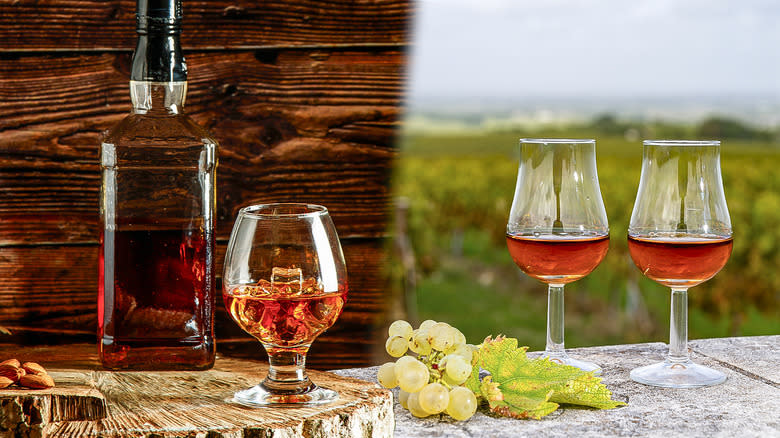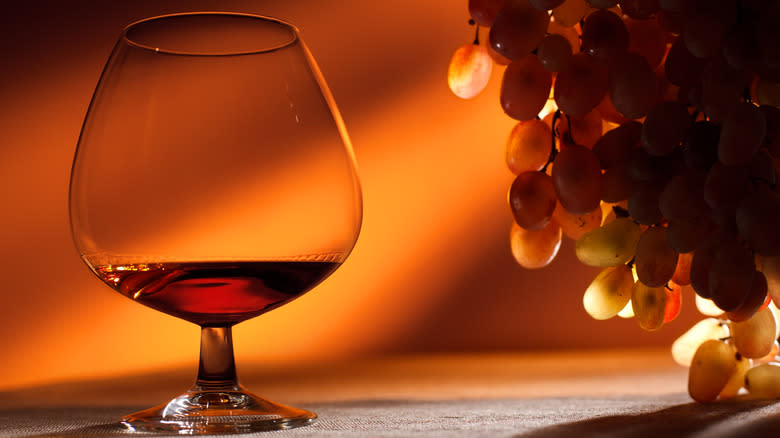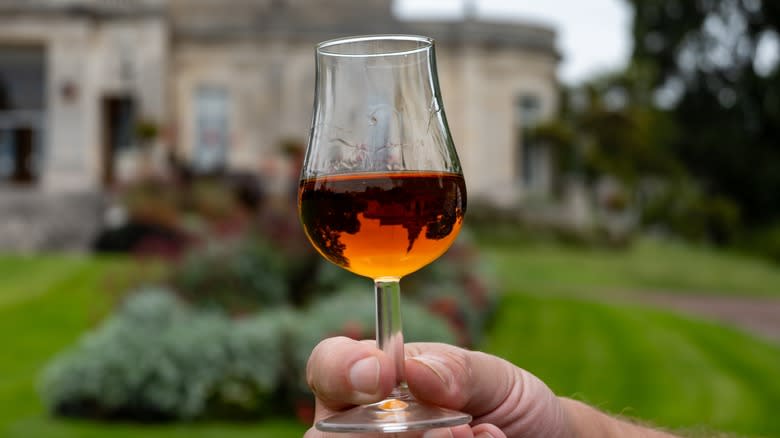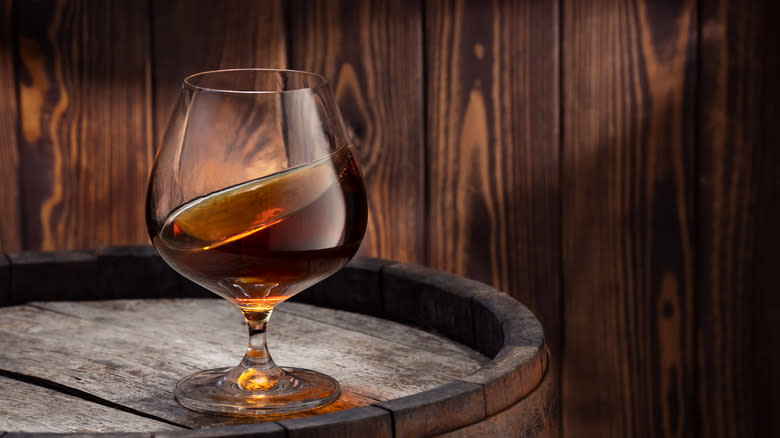Cognac Vs Brandy: What's The Difference?

The drink of choice for rail tycoons and hip-hop artists alike, brandy has been around for 700 years and is still going strong. But wait a second, we thought Nas and Jay-Z liked Cognac — not brandy. Turns out they aren't actually all that different. Speaking generally, Cognac is a type of brandy in much the same way that bourbon is a type of whiskey. Brandy is the genre of liquor, Cognac is a specific type of alcohol within that genre. Of course, the differences go deeper than that.
Brandy is a famously broad category of alcohol, so much so that there are several subgenres of brandy that are treated as their own category separate from the others. Pisco is a good example of this, as is grappa. Pisco is a fruity South American spirit popular in Peru and Chile, while grappa is an intense digestif popular in Italy. Neither of these spirits are normally referred to as brandy and will often be treated as separate categories of alcohol legally despite technically both being brandy. And these aren't the only two treated this way.
Cognac, on the other hand, is firmly recognized as a type of brandy. You would be hard-pressed to find someone in the Cognac industry who is unaware that they make brandy; there's no confusion here. Understanding what makes Cognac unique from brandy would almost be easier if they were further apart, but Cognac's unique character does shine through in the end.
Read more: 13 Liquors Your Home Bar Should Have
What Is Brandy?

It may not be the most popular drink at the bar today, but brandy hasn't lost much of its charm over the years. Brandy is a genre of alcohol categorized as any spirit that is distilled from fruit. At first glance, this would seem to indicate that wine is a type of brandy — it isn't, though brandy can be made from wine.
The important distinction is the distillation, which is the process of condensing alcohol through evaporation. Undistilled alcoholic beverages can't go higher than 15% alcohol by volume (ABV) because the yeast that is producing the alcohol can't survive in that high of a concentration of alcohol. If you want your drink to have a higher ABV than 15%, distillation is required.
Although many brandies are made from grapes, any type of fruit is allowed. Pear brandy and apple brandy are popular alternatives, though it's worth pointing out that grape brandy is normally the only one that is identified as just "brandy" without the fruit modifier. The name brandy comes from the Dutch brandewijn, which translates as burnt wine. First produced in France around the year 1313, it didn't become widely available until the 16th century. This makes it one of the earliest distilled spirits in the world. Originally produced as a medicine, it has grown to become a status symbol for luxury drinkers and clout chasers alike.
What Is Cognac?

Cognac is arguably the most famous member of the brandy family. It encompasses reputable brands such as Hennessy, Rémy Martin, and Martell — titans in their own right. Before we get more in-depth about what makes Cognac unique from other types of brandy, let's make sure we're on the same page about what it is that we're referring to.
Understanding what makes a Cognac a Cognac requires a little know-how about French protectionism. France understands that much of its reputation globally revolves around its production of luxury goods. From alcoholic beverages to fine cheese, the French have created a system around the appellation d'origine contr?lée (AOC) which translates as controlled designation of origin.
Essentially, French companies are able to label their products as AOC if they follow the guidelines laid out by the regulatory system. The regulations ensure that the product is high quality, which helps French goods retain their reputation. Because of this system, it is illegal to label bubbly white wine as Champagne unless it is produced in Champagne, France. In the same way, Cognac exclusively comes out of the southwest region of Cognac, France. At a very basic level, Cognac is any brandy that is produced in Cognac and follows the AOC guidelines set out by the French government. Those guidelines are what give Cognac its distinct profile while being loose enough to allow for creativity within the genre — a necessary component for good craft.
Ugni Blanc, King Of Grapes

Technique is important and process is key, but you'll never understand Cognac until you understand what it's made of. Ugni blanc is a white grape that's highly acidic, low in alcohol, and somewhat dry. Although it isn't the only grape Cognac is made from, it does cover roughly 98% of all Cognacs produced today, according to Cognac brand Martell. That other 2% is mostly made up of folle blanche, but this wasn't always the case.
Before the turn of the 20th century, folle blanche made up the largest portion of Cognac production. That all ended when a plague of phylloxera lice tore through the vineyards. Since then, ugni blanc has quickly become the star player due in no small part to its natural resistance to disease. Its high acidity helps keep the wine from going bad before it can be distilled, and its low alcohol content is good for the flavor since it can be more concentrated.
In general, brandy is made from a wide variety of ingredients. For grape brandies, each region prefers its own varietals. For example, most Chilean pisco is made from muscat, while Spanish brandy predominantly uses airén. Grappa, the Italian brandy, is made from pomace, which is just the skins, stems, and seeds of grapes — no juice.
Distilled Twice, Enjoyed Forever

Cognac is one of the very few brandies that's double distilled. Supposedly, the Lord of Segonzac, Chevalier de la Croix Maron, is responsible for the introduction of double distillation to Cognac. One version of the story says that he found his wife in bed with another man when he returned home from the Crusades and killed them in a fit of rage. That night, he dreamt that the devil boiled his soul in a cauldron over a fire, but his faith proved too strong, so the devil boiled him again. When he woke up, he used this idea of boiling twice as inspiration to better extract the soul of his brandy.
The real story behind the practice of double distillation for Cognac is probably less theatrical, but it does make for a good story and even better brandy. The wine is usually distilled in alembic copper pot stills called Charentais. The first distillation happens in a big batch before being separated into a smaller still for the second run. Other types of brandy may also use alembic copper pot stills, but many incorporate the more modern column stills, which can handle more volume and don't need to be cleaned after each use, significantly increasing the volume output capabilities of the distillery. As for which is better, that seems to be up to personal taste. It is certainly possible to make good brandy with either method.
Aging Like Fine Wine

Similar to other spirits, brandy is often aged in barrels. There are unaged brandies but, at least in the U.S., they must be labeled as immature brandy. The process of aging, or maturation, plays such an important role in a particular brandy's identity that they have special titles for it. You may have seen brandy labeled as V.S., VSOP, or X.O. These are acronyms for Very Special, Very Superior Old Pale, and Extra Old and refer to brandy that is at least two, four, or six years old, respectively.
Cognac is required to be aged for at least two years in oak barrels, but the process is far from straightforward. Cognac distilleries have Master Blenders, who are highly trained professionals responsible for blending together sometimes dozens of different vintages to create a consistent end product. Although it is permitted by the AOC to create an unblended Cognac, it isn't very common. If you ever see a bottle with a specific age statement instead of the more general VSOP or X.O. labels, you'll know it's unblended, but this is rare.
As part of its maturation, Cognac distilleries may add something called boise to the barrel. Boise is a tar-like substance made from boiling wood that's added to the barrel to mix with the spirit as it ages. There is a slight controversy around its use among Cognac purists, but it helps younger batches acquire the distinct woody taste distillers are looking for quicker.
Read the original article on Tasting Table.
